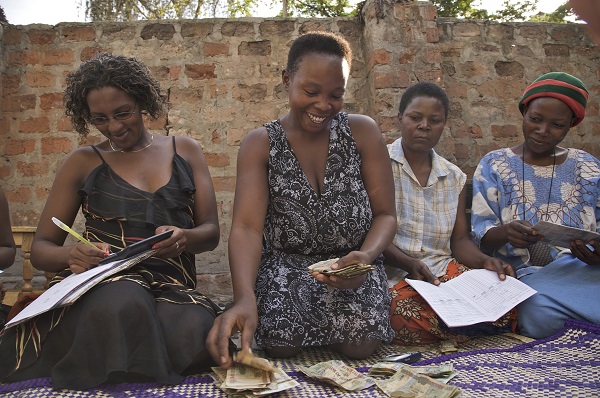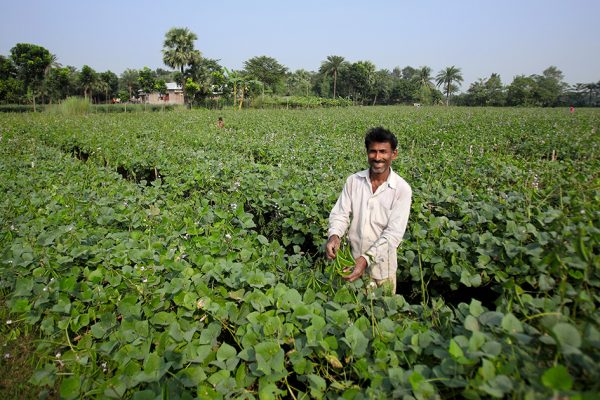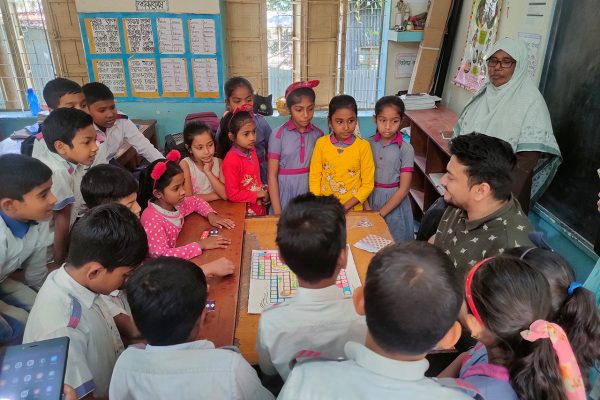Do-it-yourself finance goes global
Reading Time: 3 minutes
A lack of formal financial services serving the poor and even middle income households leads to those households finding ways to supply financial services themselves. Wealthy country or not.

A Village Organization meeting in BRAC’s Uganda Microfinance Program, where locally hired Microfinance Officers and elected Village Organization officers share responsibilities for approving loans and applications for membership. (Photo: BRAC)
This week on the Planet Money podcast, journalists Alex Blumberg and Marianne McCune delve into a new project called the U.S. Financial Diaries. The project tracked every dollar that came into and out of more than 200 low and middle-income American households. Based on the diaries from the project, Blumberg and McCune took a look at a couple examples of “do-it-yourself” financial systems. These are mechanisms, some as simple as stashing money around the house in mattresses or cookie jars, that people have created as alternatives to the existing formal financial system. Why do they create them? Blumberg and McCune explain:
Blumberg: Economists call it “consumption smoothing.” The times we get money don’t always line up with the times we need money. So, sometimes we save money ourselves and dip into that money when we need it, and sometimes we borrow from other people who’ve saved money.”
McCune: If you have a credit card, this kind of thing is invisible. If you don’t, you actually have to find someone who can fulfill that role
You might recall that is exactly what was detailed in the landmark book Portfolios of the Poor, published in 2009, which also used diaries to detail the financial lives of 250 households in Bangladesh, India, and South Africa. On average, researchers for Portfolios of the Poor found, a household had around seven active financial arrangments–deposits made or loans disbursed–at any given time. Many households handled multiple times more cash than they actually earned in a year–all primarily for the purpose of consumption smoothing.
You can blame the collapse of a flawed formal financial system, blame colonial legacies or political elites finding ways to control banks, blame poor regulations and poorly run regulatory systems that prevent banks from reaching the poor, or blame conflict–whatever the cause, a lack of formal financial services serving the poor and even middle income households leads to those households finding ways to supply financial services themselves. Wealthy country or not.
But there’s something that may be even more important, in the bigger picture, than consumption smoothing. Blumberg and McCune tell the story of Miguelo, a man who came out of a prison term having taken a financial management class and ended up being an informal banker–you might say microbanker–to the people in his neighborhood of West Harlem, in New York City.
McCune: He’s not being a bank as a business, but he took this [financial literacy] class and he got really into trying to help people manage their money and learn how to use credit. And then there’s a more surprising bank-ish thing that Miguelo does–he actually accepts deposits, like from his much less frugal brother…
Blumberg: Like a bank, Miguelo takes deposits, but unlike a bank, when the depositor comes back to get his money out, Miguelo doesn’t just give it to him. He asks him a bunch of tough questions first, like “what are you gonna use the money for? you’re not going to do anything stupid, right?”…
McCune: So this is another thing that distinguishes the formal financial system from the informal systems like Miguelo’s–Miguelo is part banker, part social worker.
Blumberg: There’s actually a social aspect to a lot of these informal financial systems. The social aspect is actually a big reason why people use them.
In the second half of the story, Blumberg and McCune tell the story of a “Sou-Sou,” an informal arrangement where a group of shareholders, which may be one person or a household, pledge to each other to put a certain small amount of money into a pot that each shareholder then takes turns taking home. In Portfolios of the Poor, these wildly popular mechanisms were labeled “rotating savings and credit associations” or ROSCAs.
Why the name “Sou-Sou”? The women in Blumberg and McCune’s story are most likely immigrants from West African countries, who among others have imported the mechanism to America. The advantage over a formal savings account, as the women note, is the peer pressure to be responsible for your share each month. The group has kicked out members who have missed payments.
Whether it’s a one-man microbanker or a Sou-Sou, either arrangement features the poor themselves playing a vital, decision-making role in making their lives and the lives of those around them better. More than any consumption-smoothing benefit, the poor seek and deserve as much power over their own lives as anyone else. That’s as true in America as it is in West Africa, East Africa, South Asia or anywhere else, and that’s why in its program designs BRAC tries to put as much decision-making power as is practical in the hands of the poor themselves, including and especially when it comes to microfinance.





